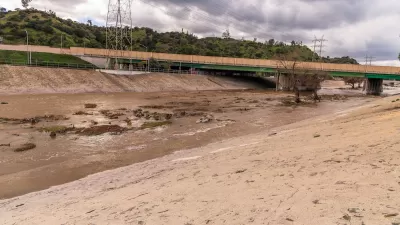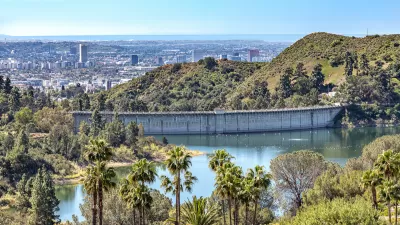County officials hope reclamation efforts will help the region reduce its dependence on imported water supplies.

Los Angeles County captured 33 billion gallons of stormwater from the recent rains that drenched California, an amount that “could supply 816,000 people with water for a year,” reports Carlos Granda for ABC7. As Granda explains, “The county Public Works Department operates 14 major dams and 620 miles of rivers and flood control channels.”
One way the county collects rainwater during storms is through a series of ‘Valley Rubber Dams’ on the San Gabriel River, which can be inflated to hold water when needed. Water is then distributed to spreading facilities designed to let water soak into the earth to replenish groundwater supplies. “Approximately 98% of stormwater runoff collected from the San Gabriel River and Rio Hondo Channel is conserved, according to officials.”
Local officials plan to boost stormwater retention and use more local water supplies to reduce dependence on imported water. Southern California has historically drawn water from the state’s Owens Valley, the Colorado River, and other sources such as Mono Lake, where a conservation nonprofit recently requested a suspension of water diversion to Los Angeles to protect the lake’s critical Califoprnia gull habitat.
FULL STORY: LA County captures 33 billion gallons of stormwater from winter storms

Alabama: Trump Terminates Settlements for Black Communities Harmed By Raw Sewage
Trump deemed the landmark civil rights agreement “illegal DEI and environmental justice policy.”

Planetizen Federal Action Tracker
A weekly monitor of how Trump’s orders and actions are impacting planners and planning in America.

The 120 Year Old Tiny Home Villages That Sheltered San Francisco’s Earthquake Refugees
More than a century ago, San Francisco mobilized to house thousands of residents displaced by the 1906 earthquake. Could their strategy offer a model for the present?

LA’s Tree Emergency Goes Beyond Vandalism
After a vandal destroyed dozens of downtown LA trees, Mayor Karen Bass vowed to replace them. Days later, she slashed the city’s tree budget.

Sacramento Leads Nation With Bus-Mounted Bike Lane Enforcement Cameras
The city is the first to use its bus-mounted traffic enforcement system to cite drivers who park or drive in bike lanes.

Seattle Voters Approve Social Housing Referendum
Voters approved a corporate tax to fund the city’s housing authority despite an opposition campaign funded by Amazon and Microsoft.
Urban Design for Planners 1: Software Tools
This six-course series explores essential urban design concepts using open source software and equips planners with the tools they need to participate fully in the urban design process.
Planning for Universal Design
Learn the tools for implementing Universal Design in planning regulations.
Ada County Highway District
Clanton & Associates, Inc.
Jessamine County Fiscal Court
Institute for Housing and Urban Development Studies (IHS)
City of Grandview
Harvard GSD Executive Education
Toledo-Lucas County Plan Commissions
Salt Lake City
NYU Wagner Graduate School of Public Service





























